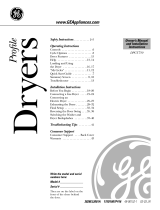3
Consumer SupportTroubleshooting TipsOperating InstructionsSafety Instructions
ge.com
WARNING!
YOUR LAUNDRY AREA
■ Keep the area underneath and around
your appliances free of combustible materials
(lint, paper, rags, etc.), gasoline, chemicals and
other flammable vapors and liquids.
■ Keep the floor around your appliances clean
and dry to reduce the possibility of slipping.
■ Close supervision is necessary if this appliance is
used by or near children. Do not allow children
to play on, with or inside this or any other
appliance.
■ Keep all laundry aids (such as detergents,
bleaches, etc.) out of the reach of children,
preferably in a locked cabinet. Observe all
warnings on container labels to avoid injury.
■ Never climb on or stand on the dryer top.
WHEN USING YOUR DRYER
■ Never reach into the dryer while the drum is
moving. Before loading, unloading or adding
clothes, wait until the drum has completely
stopped.
■ Clean the lint filter before each load to prevent
lint accumulation inside the dryer or in the
room. DO NOT OPERATE THE DRYER WITHOUT
THE LINT FILTER IN PLACE.
■ Do not wash or dry articles that have been
cleaned in, washed in, soaked in or spotted
with combustible or explosive substances (such as
wax, oil, paint, gasoline, degreasers, dry-cleaning
solvents, kerosene, etc.) which may ignite or
explode. Do not add these substances to the
wash water. Do not use or place these substances
around your washer or dryer during operation.
■ Do not place items exposed to cooking oils in
your dryer. Items contaminated with cooking oils
may contribute to a chemical reaction that could
cause a clothes load to catch fire.
■ Any article on which you have used a cleaning
solvent or that contains flammable materials
(such as cleaning cloths, mops, towels used in
beauty salons, restaurants or barber shops, etc.)
must not be placed in or near the dryer until
solvents or flammable materials have been
removed. There are many highly flammable
items used in homes such as acetone, denatured
alcohol, gasoline, kerosene, some household
cleaners, some spot removers, turpentines,
waxes, wax removers and products containing
petroleum distillates.
■ The laundry process can reduce the flame
retardancy of fabrics. To avoid such a result,
carefully follow the garment manufacturer’s
care instructions.
■ Do not dry articles containing rubber, plastic
or similar materials such as padded bras, tennis
shoes, galoshes, bath mats, rugs, bibs, baby pants,
plastic bags, pillows, etc. that may melt or burn.
Some rubber materials, when heated, can under
certain circumstances produce fire by
spontaneous combustion.
■ Do not store plastic, paper or clothing that
may burn or melt on top of the dryer during
operation.
■ Garments labeled Dry Away from Heat or Do Not
Tumble Dry (such as life jackets containing Kapok)
must not be put in your dryer.
■ Do not dry fiberglass articles in your dryer.
Skin irritation could result from the remaining
particles that may be picked up by clothing
during subsequent dryer uses.
■ To minimize the possibility of electric shock,
unplug this appliance from the power supply
or disconnect the dryer at the household
distribution panel by removing the fuse or
switching off the circuit breaker before
attempting any maintenance or cleaning
(except the removal and cleaning of the lint
filter). NOTE: Turning the Cycle Selector knob
to an off position or pressing PAUSE does NOT
disconnect the appliance from the power supply.





















